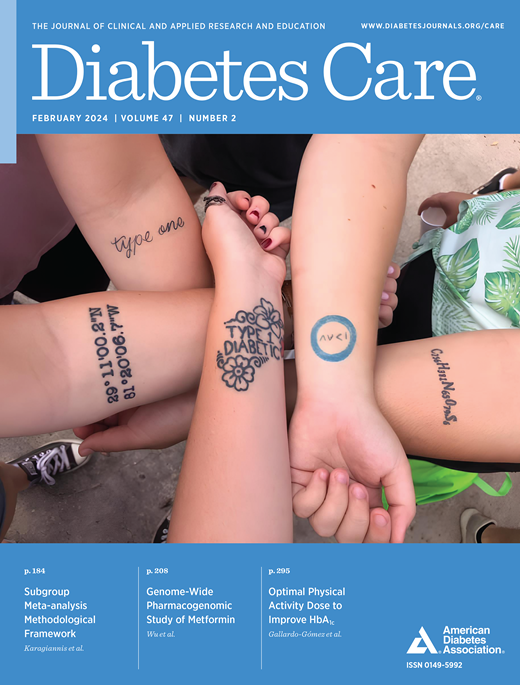Impact of Baseline GLP-1 Receptor Agonist Use on Albuminuria Reduction and Safety With Simultaneous Initiation of Finerenone and Empagliflozin in Type 2 Diabetes and Chronic Kidney Disease (CONFIDENCE Trial)
IF 16.6
1区 医学
Q1 ENDOCRINOLOGY & METABOLISM
引用次数: 0
Abstract
OBJECTIVE The CONFIDENCE trial demonstrated additive benefits of simultaneous initiation of finerenone, a nonsteroidal mineralocorticoid receptor antagonist, and a sodium–glucose cotransporter 2 (SGLT2) inhibitor compared with monotherapy in reducing the urinary albumin-to-creatinine ratio (UACR). This prespecified analysis evaluated whether safety and efficacy of combination therapy varies by baseline glucagon-like peptide 1 receptor agonist (GLP-1 RA) use. RESEARCH DESIGN AND METHODS Adults with chronic kidney disease (UACR ≥100 to <5,000 mg/g; estimated glomerular filtration rate [eGFR] 30–90 mL/min/1.73 m2) and type 2 diabetes (glycated hemoglobin <11% [97 mmol/mol]) were randomized (1:1:1) to once-daily finerenone, empagliflozin, or finerenone plus empagliflozin. RESULTS Among 800 participants, 182 (23%) used a GLP-1 RA at baseline. At day 180, UACR change from baseline in participants using a GLP-1 RA was −51% (95% CI −59 to −40%) with combination therapy, −34% (−48 to −18%) with finerenone, and −36% (−48 to −21%) with empagliflozin. Corresponding results in those not using a GLP-1 RA at baseline were −56% (−62 to −50%), −37% (−45 to −28%), and −33% (−41 to −23%), respectively. Hyperkalemia incidence rates with combination therapy were 9.0% and 9.5% among individuals with and without baseline GLP-1 RA use. eGFR changes were consistent among individuals with and without baseline GLP-1 RA use. Acute kidney injury was uncommon. Decreases in systolic blood pressure were observed and were more pronounced with combination therapy. CONCLUSIONS In CONFIDENCE, simultaneous initiation with finerenone and an SGLT2 inhibitor was effective and well tolerated compared with monotherapy, irrespective of background use of a GLP-1 RA.基线使用GLP-1受体激动剂对2型糖尿病和慢性肾病患者同时开始使用非尼伦酮和恩格列净时蛋白尿减少和安全性的影响(CONFIDENCE试验)
目的:CONFIDENCE试验表明,与单一治疗相比,同时服用芬尼酮、非甾体矿皮质激素受体拮抗剂和钠-葡萄糖共转运蛋白2 (SGLT2)抑制剂在降低尿白蛋白与肌酐比率(UACR)方面具有附加益处。这项预先指定的分析评估了联合治疗的安全性和有效性是否因基线胰高血糖素样肽1受体激动剂(GLP-1 RA)的使用而变化。研究设计和方法慢性肾脏疾病(UACR≥100 ~ 5000 mg/g,估计肾小球滤过率[eGFR] 30 ~ 90 mL/min/1.73 m2)和2型糖尿病(糖化血红蛋白[97 mmol/mol] 11%)的成人(1:1:1)随机分为每天一次的芬尼烯酮、恩帕列净或芬尼烯酮加恩帕列净组。结果:在800名参与者中,182名(23%)在基线时使用GLP-1 RA。在第180天,使用GLP-1 RA的参与者的UACR较基线变化在联合治疗组为- 51% (95% CI为- 59至- 40%),在芬尼酮组为- 34%(- 48至- 18%),在恩格列净组为- 36%(- 48至- 21%)。基线时未使用GLP-1 RA的相应结果分别为- 56%(- 62%至- 50%)、- 37%(- 45%至- 28%)和- 33%(- 41%至- 23%)。在基线是否使用GLP-1 RA的个体中,联合治疗的高钾血症发生率分别为9.0%和9.5%。eGFR变化在基线GLP-1 RA使用和未使用的个体中是一致的。急性肾损伤不常见。观察到收缩压下降,联合治疗更明显。结论:在CONFIDENCE中,与单药治疗相比,同时使用芬尼酮和SGLT2抑制剂有效且耐受性良好,与GLP-1 RA的背景使用无关。
本文章由计算机程序翻译,如有差异,请以英文原文为准。
求助全文
约1分钟内获得全文
求助全文
来源期刊

Diabetes Care
医学-内分泌学与代谢
CiteScore
27.80
自引率
4.90%
发文量
449
审稿时长
1 months
期刊介绍:
The journal's overarching mission can be captured by the simple word "Care," reflecting its commitment to enhancing patient well-being. Diabetes Care aims to support better patient care by addressing the comprehensive needs of healthcare professionals dedicated to managing diabetes.
Diabetes Care serves as a valuable resource for healthcare practitioners, aiming to advance knowledge, foster research, and improve diabetes management. The journal publishes original research across various categories, including Clinical Care, Education, Nutrition, Psychosocial Research, Epidemiology, Health Services Research, Emerging Treatments and Technologies, Pathophysiology, Complications, and Cardiovascular and Metabolic Risk. Additionally, Diabetes Care features ADA statements, consensus reports, review articles, letters to the editor, and health/medical news, appealing to a diverse audience of physicians, researchers, psychologists, educators, and other healthcare professionals.
 求助内容:
求助内容: 应助结果提醒方式:
应助结果提醒方式:


